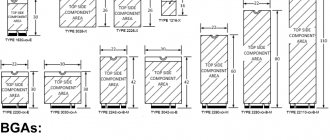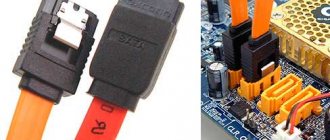With the development of image transmission technologies, users often began to wonder what is better than HDMI or VGA?
It is worth understanding that today users cannot always correctly imagine certain aspects of the picture that is reproduced on the monitor. Simply put, it is believed that a smooth, high-quality image transmitted to the screen is largely due to a good monitor and the power of computer equipment.
It's not correct to say that. The fact is that the type of connecting connector, as well as the cable that is used, plays a significant role here. Let's try to compare VGA vs HDMI interfaces.
Fig No. 1. Image of VGA connector
Fig No. 2. Image of HDMI connector
Story
The abbreviation HDMI stands for High Definition Multimedia Interface, which translates as High Definition Multimedia Interface.
Information about it first appeared at the beginning of the 21st century, and the companies that began to use it are called such “giants” as Panasonic and Philips. Today, this technology is controlled by only one company – Silicon Image. To be more precise, its division is HDMI Licensing.
Speaking of VGA, it means a 15-pin subminiature analog connector that allows you to connect a monitor and a projector. It was developed back in 1987 and was intended for monitors operating on the basis of cathode ray tubes.
By 2010, this standard was outdated and was being actively replaced by the HDMI interface. In 2020, electronics manufacturers such as Intel and AMD announced that they would completely abandon the use of this standard.
Using adapters or adapters
Any adapter reduces the quality of image transmission and the speed of sending data. It is advisable to use adapters from one to another connectors if no other connection options are provided. For example, if you choose a low-quality Dp adapter when transmitting a video signal, an HDCP error appears, the image flickers, or the image is completely lost.
There are 2 types of adapters for display ports: passive and active. Only the second option, when connecting a PC and one screen, provides full support for display configurations. To connect more than 2 monitors at a time, it is better to use passive adapters.
Adapters for HDMI are not required in modern TVs and laptops. Most often, such a connector is already provided in the basic configuration of the equipment. This simplifies the connection and allows you to enjoy full quality digital sound and picture.
Design
Today, HDMI has five main types of connectors.
Here we are talking about:
- HDMI (Type-A);
- mini-HDMI (Type-C);
- micro-HDMI (Type-D).
Most often, we use the first one – Type-A. It is used in computers, laptops, TVs and monitors. Less commonly you can find Type-C used for the same purposes. Manufacturers use Type-D least often.
Fig No. 3. Image of HDMI connectors (Type-A, Type-C and Type-D)
There are also HDMI (Type-B) and HDMI (Type-C). They are used to transmit images with a resolution exceeding 1080p and in vehicles, respectively.
By its design, the cable consists of the following parts:
- Braid made of rubber material.
- Braid made of wires.
- Aluminium foil.
- Vita pairs designed for data transmission.
- Power and signal control wire.
Fig No. 4. Sectional view of HDMI cable
In cross-section, the VGA cable consists of 14 conductors, which are divided into special HD15 connectors. Note that they are equipped with gold-plated contacts, as well as screws to ensure fixation. Most often, there are cables that consist of three coaxial cables, two twisted pairs, and seven single conductors designed to provide signal transmission for synchronization purposes.
Fig No. 5. Sectional view of VGA cable
Comparison HDMI vs DP
So, both cables are designed to transmit image, video and sound. Different versions of HDMI are capable of supporting an Internet connection. All DP versions have high throughput with information transfer rates of up to 25.92 Gbps.
Only the display port is capable of simultaneously transmitting sound and image to 4 monitors. HDMI only works with one channel. That is, it can be used to connect one display to one PC.
The length of DP is significantly shorter than that of HDMI. For long-distance connection of high-quality digital TV, it is better to choose a familiar connector. But for personal computer monitors located near the system unit, a display module is perfect.
Important! Not all equipment is equipped with a DP input. Only modern versions of PCs, laptops, monitors, TVs have such an input. You should pay attention to this first of all when choosing a cable.
Sound transmission process
The audio signal transmission process is one of those functions that needs special emphasis.
Today, almost all manufacturers of multimedia equipment install dynamic emitters in their devices. This includes computers and monitors. For this reason, the user does not need to purchase a separate speaker system. In this case, to play sound on a TV or monitor, you will need to connect to the sound source using an HDMI cable.
Speaking about VGA, this interface cannot transmit sound.
Don't forget about audio
High-definition images and video are not the only benefits of HDMI technology. Unlike VGA, HDMI can transmit high-quality audio through the HDMI port. When connecting your computer or other movie streaming device to your TV using a VGA cable, you need to connect additional cables from your computer's sound card to the TV's audio input. Without these cables, you are limited to using your computer speakers for audio. This is the main reason why more and more electronics manufacturers are incorporating HDMI into multimedia devices rather than using only the DVI interface, which does not carry audio.
Image quality
By using an HDMI cable, the display will display high-resolution images. All this is due to the fact that graphics adapters and other multimedia devices are fully adapted to this interface.
Speaking about the VGA standard, it takes much more time to convert an analogue signal into a digital one. As a result, data loss occurs.
Another negative factor for VGA is its inability to withstand various types of interference. First of all, these include:
- Radio waves.
- High frequency radiation.
Alternative for connecting PC monitors
The priority for game consoles and PCs with powerful monitors is modern Displayport. In second place in terms of quality of sound and image transmission is HDMI 2.1. As an alternative to the two proposed options, gamers and programmers use the DVI connector.
These types of ports can still be found on most PC graphics cards. Their value lies in the reliable connection using two screws. DVI connectors are gradually becoming obsolete. But they will allow you to support frequencies up to 144 Hz, resolution up to 1080p. Whereas the new HDMI 1.4 cannot allow this.
The DVI standard is still considered one of the best for gaming stations. The maximum image resolution is up to 2560 by 1600 pixels with a refresh rate of 60 Hz. So, with their help it is easy to connect monitors whose quality reaches 1440p.
Modern DVI transmits analog and digital signals. That is, single-channel and dual-channel cable options are available on the market. The model with two channels and digital data transmission is much more popular. It does not, like its analogue, limit the quality to 1920 by 1200 pixels.
Spreading
Due to the fact that companies have long abandoned the use of VGA, HDMI is becoming more widespread. At the same time, the VGA interface can be found on outdated equipment that was released, most often before 2010.
So, we have finished our comparison of VGA and HDMI interfaces.
Of course, HDMI is an order of magnitude better in terms of its performance. If we are talking about the use of outdated technology, then VGA may also be relevant in use.
Technologies
- home
- »
- Helpful information
- »
- How to connect HDMI to VGA or VGA to HDMI. What are their similarities and differences. How to connect HDMI to VGA or VGA to HDMI. What are their similarities and differences.
How to connect HDMI to VGA or VGA to HDMI. What are their similarities and differences.
As an example, we take the VGA (Video Graphics Logic Array) connector and the HDMI (High Definition Multimedia Interface) connector. Since both of these connectors are made for video transmission, it would make sense that a person should be able to connect them together simply by making a cable with the correct connectors on both ends. However, this theory is far from the truth. VGA and HDMI are extremely different systems that don't even speak the same language, even though they both transmit video signals. VGA was created as a video standard for computer monitors in 1987. On the other hand, HDMI was created in 2002, making it the most relevant modern connection option.
So, what's the difference between VGA and HDMI? In fact, there are many differences between them. The first and probably most important thing is that the VGA connector uses an analog signal, while the HDMI connector uses a digital signal. The second difference between VGA and HDMI signals is that VGA is simply a video signal, while HDMI carries not only video but also a stereo audio signal. Another difference is that the VGA connector and the HDMI connector are simply not the same. You can't just connect a wire from one source to another receiver. The big difference between the two is the resolution difference between VGA and HDMI. When we use the term “native resolution” we are talking about the actual number of rows and columns of pixels (dots of color) that appear on the screen. Initially, on VGA it was created in four different graphics modes: 640 x 480 pixels in 16 colors 640 x 350 pixels in 16 colors 320 x 200 pixels in 16 colors 320 x 200 pixels in 256 colors. Initially, the resolution was not high, but VGA's predecessor was CGA, which had only 320 x 200 pixels. Since then, many new modifications have been developed for VGA including: SVGA (super VGA) monitor whose resolution is 800 x 600 pixels. XGA (Extended Graphics Array) resolution, which is 1024 x 768 pixels WXGA (Wide Graphics Array) resolution, which is usually 1280 x 768 or 1280 x 800 pixels, allowing you to use widescreen monitors for watching movies All of these are different formats (there are a lot of them quantity) are still considered part of the VGA family. They all use the same D-subminiature connector and any transmission device with a VGA connector can connect any image display device that has a VGA connector. The HDMI connector, which is designed primarily for use with HDTV, comes in two main flavors: 720p, which has 720 horizontal pixel lines, making the actual resolution 1280 x 720, and 1080p, which has 1080 horizontal pixel lines, making the actual resolution 1920 x 1080 When a monitor cannot display more rows and pixels as supplied to it by the signal source, it either crops the edges of the image, or usually cuts out some of the rows and columns of pixels, allowing the image to be output correctly. If a monitor has the ability to display more rows of pixels than what is being transmitted from the signal source, it duplicates the rows and columns of pixels, making the image larger. This process of changing the number of resolution lines from the input signal is called “scaling”. An HDTV signal has more lines of resolution than a regular VGA signal, so it needs to be upscaled while at the same time being converted from analog to digital.
To connect HDMI to VGA or VGA to HDMI, special devices are used - converters, signal converters, which you can find on our website. These devices contain a complex conversion circuit and contain a special chip that converts either an analog signal + sound into a digital one, or vice versa, a digital signal into an analog + sound one.
In what cases should these converters be used? For example, we have an ordinary monitor with a VGA connector and want to connect a device with an HDMI output to it, for example: a laptop, DVD player, HD video camera, game console, satellite TV, etc. For this we need a device - a converter from HDMI to VGA. Such converters come with support for audio transmission from HDMI and without audio, which transmit exclusively the image to the receiver (monitor, projector, LCD, etc.) from VGA.
Now consider the following case, when we need to transfer an image from VGA to an HDMI signal. For example, feed an image from a computer, laptop, or other device with a VGA output to a TV, monitor, LCD projector or plasma panel with an HDMI input. For this we need a VGA to HDMI converter.
Conclusion: with the help of a converter we solve the problem of communication between the HDMI and VGA connectors and can enjoy high-quality pictures.
How to choose the right cable
For resolutions up to 1440p, a DVI cable is sufficient. It has an affordable price. And the variability of connection length. In all other cases, you must pay attention to the following characteristics:
- Availability of inputs for different connectors on the TV and monitor. If there is a DP input and the connection distance is less than 3m, it is better to choose it.
- Required broadcast quality. 4K – can transmit HDMI 2.0 and 2.1. 8K resolution is best broadcast via Displayport.
- Device connection range. Only HDMI can handle up to 10 m. DP is designed only for close connection of equipment.
- Required information transfer speed. For high-speed transmission up to 120 Hz, the display port is better suited.
- Number of connected monitors. HDMI can only connect one device. DP copes with 4 monitors without loss of sound quality, image quality and data sending speed.
For digital television, a modern version of HDMI 2.0 or 2.1 is sufficient. But for games and powerful monitors, it is best to choose a display port. Older versions of equipment that support a DVI connector, where 3D or Full HD format is not required, can be equipped with a “native” digital DVI cable.
Now you know all the features of an HDMI cable and Displayport. You understand in what situations it is better to choose the second option. And when a standard cable is required. And remember, the main thing is to pay attention to the standard connectors that are installed in the computer, monitor or TV itself.
Found a mistake? Select it and press ctrl+enter
- 100
What is better DisplayPort or HDMI
We have described the main differences between the two digital interfaces, and summarizing the article we can highlight the main points in comparing the two standards:
- HDMI is aimed more at mainstream consumer electronics, while DP is aimed at high-end computers;
- DP has higher bandwidth compared to HDMI;
- DP has an additional AUX channel, and HDMI has CEC;
- DP is less popular compared to HDMI.
Of course, HDMI is not going anywhere in the coming years, however, quite soon that golden time will come for VESA Corporation, when their DisplayPort standard will be the most popular and advanced, because it is objectively stronger than HDMI. And it’s worth preparing for this.










